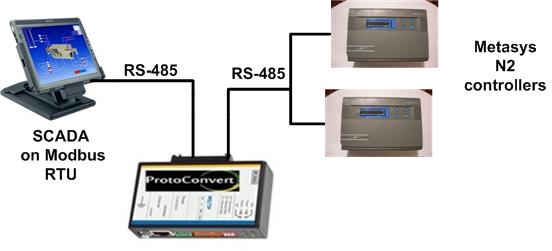1) On a site you have several Metasys N2 controllers that can provide data output on Metasys N2.
2) The site has a SCADA on Modbus RTU that needs the data from the Ion meters on Metasys N2.
3) Since the Metasys N2 controllers provide data output on Metasys N2 and the SCADA understands only Modbus RTU a direct data exchange is not possible.
Block Diagram:

Solution:
The devices can not directly communicate with each other as they are not on the same protocol. Metasys N2 is a Serial protocol, while Modbus RTU is an Ethernet based Protocol. You need something that will convert data from Modbus RTU device to Metasys N2 and vice versa.
ProtoConvert’s Metasys N2 to Modbus RTU converter will be an excellent solution for this requirement. The gateway reads data from the Energy meters on Metasys N2. It caches this data internally and then provides it on Modbus RTU when requested from the SCADA system.